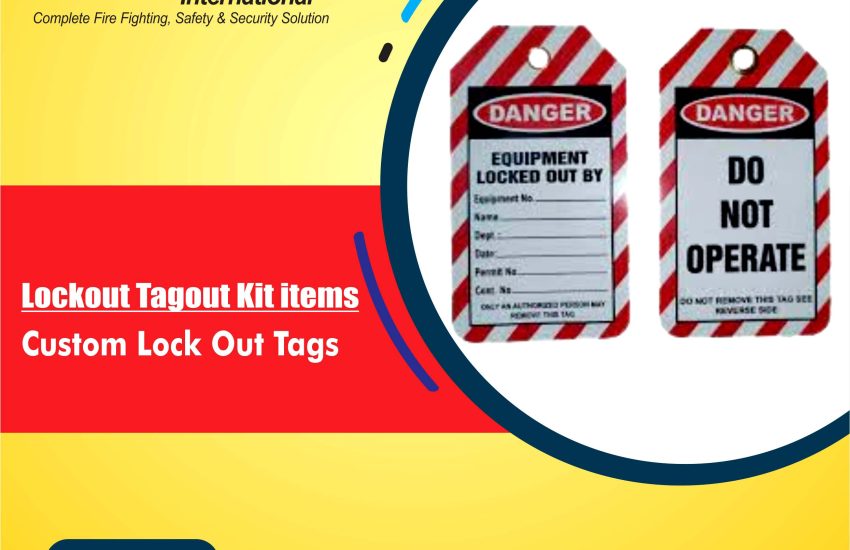Custom Lock Out Tags In today’s workplace, safety holds the highest priority. One critical element in ensuring workplace safety, particularly in industrial environments, is the use of proper lock-out/tag-out (LOTO) procedures. An important part of these procedures is custom lock-out tags. These tags serve as clear indicators for workers, helping them avoid operating equipment that is undergoing maintenance or repair. This guide provides a comprehensive overview of custom lock-out tags, covering their benefits, types, materials, and why they are vital for safety and regulatory compliance.
What Are Custom Lock-Out Tags?
Custom lock-out tags are personalized safety tags used during lock-out/tag-out procedures. Workers attach these tags to equipment that is locked out during maintenance or repair to signal that the equipment should not be operated. Businesses can customize these tags with specific information, including:
- Equipment identification
- Contact details for maintenance personnel
- Lock-out date and time
- Hazard warnings or operating instructions
By tailoring these tags, companies ensure that they meet unique safety requirements, comply with OSHA regulations, and improve communication across the workforce.
Why Are Custom Lock-Out Tags Essential?
Custom lock-out tags offer several significant benefits, particularly in terms of safety and regulatory compliance:
1. Enhanced Safety
Custom lock-out tags allow businesses to tailor safety messages to match the specific risks associated with different machines or equipment. For example, adding warnings about hazardous energy or mechanical faults can prevent accidents from occurring.
2. OSHA Compliance
OSHA requires employers to implement lock-out/tag-out procedures to protect workers from the accidental release of hazardous energy during maintenance. Custom lock-out tags help businesses adhere to these requirements, reducing the risk of injuries and penalties.
3. Improved Communication
Customizing lock-out tags provides workers with clear, concise information. This clarity helps eliminate confusion about whether equipment is safe to operate and who is responsible for the lock-out procedure. It also ensures that everyone understands the current maintenance status.
4. Durability
Custom lock-out tags are made from sturdy materials designed to withstand harsh work environments. Whether exposed to chemicals, extreme temperatures, or outdoor elements, durable tags ensure consistent visibility and reliability.
Types of Custom Lock-Out Tags
Several types of custom lock-out tag cater to different needs and work environments. Below are some of the most common types:
1. Plastic Lock-Out Tags
Plastic tags are durable, lightweight, and resistant to wear and tear. They work well in environments with high humidity or exposure to chemicals. Custom plastic tags can be printed with logos, safety instructions, and specific information.
2. Metal Lock-Out Tags
Metal tags, made from materials like aluminum or steel, are designed for heavy-duty applications. These tags are ideal for areas where machinery experiences physical stress or impact. Companies can customize them through laser engraving or printing.
3. Weatherproof Lock-Out Tags
For workplaces facing harsh weather conditions, weatherproof lock-out tag provide long-lasting durability. These tags resist fading, moisture, and other environmental factors, ensuring they remain legible and functional.
4. Self-Laminating Lock-Out Tags
Self-laminating tag have an additional layer of protection against moisture, chemicals, and wear. They are highly customizable and often feature writable surfaces to accommodate temporary information.
Materials Used for Custom Lock-Out Tags
The effectiveness of custom lock-out tag depends on the materials used. Below are some of the most common materials:
- PVC (Polyvinyl Chloride): Lightweight and chemical-resistant, PVC tags are commonly used in industrial environments.
- Vinyl: Flexible, weather-resistant, and ideal for outdoor use, vinyl tags are a versatile choice.
- Polyester: Known for its excellent chemical resistance and long lifespan, polyester is suitable for extreme environments.
- Aluminum: Strong and durable, aluminum tags work well in heavy-duty settings where strength is crucial.
Customization Options for Lock-Out Tags
When designing custom lock-out tag, businesses have various options for personalization. Some of the most popular customization choices include:
- Color Schemes: Color coding makes it easier to distinguish between different types of equipment or maintenance statuses.
- Text and Graphics: Adding safety instructions, hazard symbols, or other graphics enhances understanding.
- Size and Shape: Custom lock-out tag come in various sizes and shapes, allowing you to choose the best option for your equipment and available space.
- Barcodes and QR Codes: Adding barcodes or QR codes to tags provides easy access to additional information or maintenance records.
How to Implement Custom Lock-Out Tag
To successfully implement custom lock-out tags, follow these steps:
- Identify Equipment and Hazards: Determine which equipment requires lock-out/tag-out procedures and evaluate potential risks.
- Design Custom Tags: Create tags with essential information, ensuring they align with OSHA standards and your company’s safety protocols.
- Train Employees: Educate employees on lock-out/tag-out procedures and the proper use of custom lock-out tag.
- Regularly Inspect Tags: Periodically check custom lock-out tagsto ensure they remain visible, legible, and compliant with safety regulations.
Conclusion
Custom lock-out tag are essential tools for maintaining workplace safety and ensuring regulatory compliance. Customizing these tags allows businesses to meet specific safety needs, improve communication, and avoid costly fines. With numerous materials, customization options, and types available, companies can choose the perfect tags for their lock-out/tag-out procedures. By implementing these customized tags correctly, businesses create a safer, more efficient environment for their employees.


